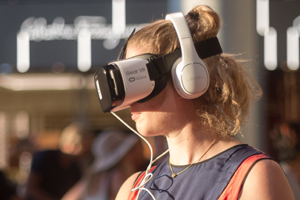It would be expensive, to say the least, for charity: water to bring 12,000 people to Ethiopia to see one of its water projects. Instead, one of the water projects was brought to a tourist-trafficked area of Manhattan.
As part of its 10th anniversary celebration, charity: water set up 16 virtual reality (VR) stations in The Winter Garden at Brookfield Place during the month of August. Thanks to an undisclosed philanthropist, a $30 donation would be unlocked every time someone watched The Source, a nine-minute VR film telling the story of Selam, a 13-year-old girl in Ethiopia who gets clean water for the first time.
VR is the latest technology used to tell nonprofits’ stories. It’s not your typical movie, where you might have a seat and view a screen. Instead, you strap on a headset and immerse yourself in the film. The viewing stations included railings to avoid any potential mishaps as viewers might gyrate or move around the indoor mall during the film.
“For people to see this amazing technology for the first time and to see our story, it’s unique,” said Christoph Gorder, chief water officer, adding that most everyone who passed through the Brookfield Place exhibit had never before seen VR.
“We like new technology. We’re just looking for ways to connect supporters to the field. That’s what GPS and Google Earth does and that’s what VR does. You have to stay ahead of the curve,” Gorder said. “Five years ago we’d launch a YouTube video and people would watch it,” but today, they’re playing the video while looking at their phone or doing something else.
There are virtual reality films by environmental organizations that can put you in a protected game refuge, where you can see large animals all around you, or put you in a beautiful environment. “People are sticking VR cameras on drones, depicting bird migration,” said Brad Lichtenstein, president of Milwaukee, Wisc.-based 371 Productions, who helped develop a VR film for Planned Parenthood.
To Mary Lynn Lalonde, virtual reality is essentially an empathy machine. “What we’ve often said to ourselves in international development is, wouldn’t it be amazing to actually take our supporters to the field? If we took them to the field, they’d support us forever,” she said.
Based in Geneva, Switzerland, La londe is global fundraising content manager for UNICEF. She is among a team that tested Clouds Over Sidra, a VR film about children in refugee camps in Jordan. The film was shortened from 7 minutes to about 4 minutes for testing in face-to-face fundraising.
Clouds Over Sidra was translated into 12 languages and tested in 22 countries. “We’re trying to apply fundraising methodology to it, testing in different spaces, making sure to apply the rigor of the usual fundraising to this new channel,” Lalonde said.
In the U.S., the film has been used more at events and with high net-worth individuals, according to Lalonde. In its country office in Mexico, UNICEF faceto-face fundraisers set up shop in a mall, looking like an airline booth and handing out boarding passes, offering tickets to “go to” Jordan via virtual reality.
“The nature of the technology is that it’s a very intensely personal experience so it does work very well in individual situations or major donors, because once people have that experience, people really want to talk about it afterward,” Lalonde said. “It creates the need for a dialogue that you’re likely to have with a supporter,” she said.
Lalonde is working on UNICEF’s next virtual reality film, to be released Oct. 24 in conjunction with World Polio Day.
“The advantage for people doing it now is because there’s the whole cool factor; that will be less cool a year from now because the pace at which this technology is changing is incredible,” said Michael Hoffman, CEO of See3 Communications, a Chicago-based digital services consulting firm and sponsor of the annual Do-Gooder Video Awards.
Lichtenstein helped to produce Planned Parenthood’s Across The Line, a 7-minute video that aims to provide a direct experience to viewers of what it’s like to cross a phalanx of protestors to get to one of its clinics.
Across The Line features a mix of 360-degree video and computer-generated material. “There’s a lot in that 360-degree environment to take in and then it switches over to a computer-generated animation that employs audio of actual protestors recorded all around the country,” said Lichtenstein. “The experience is very tense because all of the attention is shifted right to you,” he said. Another scene in the film re-enacts the experience of being in an exam room of a health center before an abortion, but not with actors.
Planned Parenthood helped raise money for the film, which premiered at Sundance and has gone on to other film festivals. The organization “realized the need for education around this kind of experience,” Lichtenstein said, adding he expects it likely will also be used for donor events and board education. VR can be appealing for organizations that do door-to-door campaigns, Lichtenstein said, because instead of handing out a leaflet or pamphlet, people can watch a brief VR video.
“Where it comes back to analog with what you might call flat films, story still really matters. As the wow factor of virtual reality starts to wear off, what’s going to make more impactful, longer lasting experiences, are the ones that have figured out how to tell interesting and well-crafted stories,” he said.
Just as a VR film can be much more intense than a conventional film, so is the production of it much more complex. Charity: water’s The Source was filmed with eight GoPro cameras essentially pulled together in a sphere on a stick, according to Gorder.
“Post-production is much more complicated. You’re stitching together all these scenes. There’s a lot of work that goes into the software,” he said.
The organization started thinking about the concept in late 2014 and the film was shot in Ethiopia in spring 2015. The final version was completed by early fall and unveiled at the charity: water gala in December. “It was an epic experience,” Gorder said, with 400 people simultaneously donning VR headsets. “As people got to the part where the village gets clean water, they started spontaneously erupting in cheers, you could see different parts of the audience hitting that part of the movie,” he said.
Charity: water had a goal of reaching 10,000 people during its month-long exhibit at Brookfield Place and Gorder said that was a stretch goal, to have people stop what they’re doing and watch a video for nine minutes.
The nonprofit will engage via email with everyone who viewed the film, which means another 12,000 email addresses. “What we’ve found is there’s a long tail on these things. This is not something that converts in a month or six months, it could be three to five years before we really see what’s actually going to happen here,” Gorder said.
“This is a way to connect people in a completely new way, in an intense way, with the reality in the field. We want people to understand what the water crisis is like. It’s part of solving the problem, telling the story,” Gorder said.
In a more intimate setting, it can be even more impactful. Gorder recalled a donor who made a large gift and was invited to meet staff at the charity: water headquarters. The donor experienced the VR video, decided he had not given enough, and wrote another six-figure check. “It [VR] really captures what’s going on, as do all good stories,” he said.
Visitors to charity: water’s SoHo office are also treated to a VR showing. The headset is essentially a Samsung Galaxy cell phone that secures into an elaborate pair of goggles. Donations from Samsung and Verizon helped secure enough headsets for the gala in December.
Google Cardboard is making virtual reality much more accessible, Gorder said, and big technology companies are investing in the space. “In three to nine months, we’re going to start to really see a lot of development in it. I think it’s the future; it’s going to become standard practice everywhere,” Gorder said. “It’s really a great way to tell stories, to get people to focus, and it blocks out the whole rest of the world. You’re not looking at YouTube while checking your stock portfolio. You’re in there.”
Hoffman, of See3, estimated that a decent conventional video might cost $25,000 to produce but a decent VR film would be in excess of $100,000. “If you have less than $100,000, there’s not a lot you’re going to do with this,” he said. The camera rigs and shoots are expensive but the editing side is much more intense. “The days needed for editing regular video — it’s an order of magnitude for this,” Hoffman said.
The accelerated pace also will mean the cost will drop, which will be vital to making VR more accessible. Nonprofits dabbling in VR video at the moment are limited to those at the cutting edge and/or those with big pocketbooks.
What’s going to happen in the next year, software will become more powerful to automatically do things that are time consuming and difficult, such as stitching together scenes from different cameras — an important distinction to VR filmmaking. It will happen much faster than people assume, he said.
VR won’t be for everybody, and not just because of the expense. “If you’re doing everything else really well, I invite you to play with this thing, to get to the next level. Charity: water has every reason to play with this; it also reinforces their brand as a leading edge, media-focused organization,” Hoffman said. “As more companies come out with headsets, soon it will be like Xbox and Wii – people will have access to it and when everyone does, you’ll have a much more useful reason to be doing it,” he said.
“This is just a powerful human experience. I think we are at the phase where no one knows where it’s going or how it’s going to play out,” Hoffman said, but the amount of investment by big companies is huge. VR will get easier and cheaper just as video did. Ten years ago, you needed $100,000 to invest in equipment to do broadcast-quality stuff, now your iPhone shoots in 4K and comes with video editing software, he said. “We’ll be on a trajectory just like that. Software and hardware side will get much more accessible, much less expensive,” Hoffman said. “It’ll happen much faster than it did with video.”











